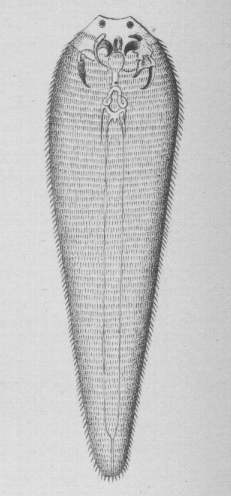- Pentastomida
Taxobox
name = Tongue worms

image_width = 200px
image_caption = "Linguatula taenioides", a pentastomid parasite of sheep
regnum =Animal ia
phylum =Arthropod a
subphylum = Crustacea
classis =Maxillopoda
subclassis = Pentastomida
subclassis_authority = Diesing, 1836
subdivision_ranks = Orders
subdivision =Cephalobaenida Porocephalida The Pentastomida are a group of parasiticinvertebrate s commonly known as tongue worms due to the resemblance of some species to a vertebratetongue .There are about 100 extant species of pentastomids; all are
obligate parasite s with correspondingly degenerate anatomy. Adult tongue worms vary from about 1 cm to 14 cm in length, and parasitize therespiratory tract s ofvertebrate s [cite book|author = Cooper Curtice|year = 1890|title = [http://alembic.nal.usda.gov:8300/Sheeppar/ The animal parasites of sheep] |location= Washington | publisher=Government Printing Office] . They have five anteriorappendage s. One is the mouth; the others are two pairs of hooks which they use to attach to the host. This arrangement led to their scientific name, meaning "five openings", but although the appendages are similar in some species, only one is a mouth.Their affinity with other invertebrates is uncertain. They grow by moulting, which suggests they belong to the
Ecdysozoa . Historically, they were considered to deserve aphylum of their own, but in 1972, Wingstrand showed similarities in the structure ofspermatozoa between pentastomids andbranchiura ns (fish lice), a group of parasiticcrustacean s [cite journal | quotes=no|author = K. G. Wingstrand|year = 1972|title = Comparative spermatology of a pentastomid, "Raillietiella hemidactyli", and a branchiuran crustacean, "Argulus foliaceus", with a discussion of pentastomid relationships|journal = Kong. Danske Videnskabelige Selsk. Biol. Skrift.|volume = 19|pages = 1–72] , and this relationship is supported by molecular evidence [cite journal | quotes=no|author = L. Abele, W. Kim, and B. E. Felgenhauer|year = 1989|title = Molecular evidence for inclusion of the phylum Pentastomida in the Crustacea|journal = Mol. Biol. Evol.|volume = 6|pages = 685–691] .However,
fossil s from the UpperCambrian identified as pentastomids ("Heymonsicambria", "Haffnericambria", "Bockelericambria") suggest that the pentastomids branched very early and may be anoutgroup to the other arthropods [cite book|author = D. Walossek and K. J. Müller|year = 1998|chapter = Cambrian "Orsten"-type arthropods and the phylogeny of Crustacea|title = Arthropod Relationships|editor = R. A. Fortey and R. H. Thomas|pages = 139–143|location= London | publisher=Chapman & Hall] .Alternative names for the Pentastomida include Pentastoma (strictly a genus name), Linguatulida, and Acanthotheca.
Classification
This article follows Martin and Davis in placing Pentastomida in the class
Maxillopoda within the subphylumCrustacea [cite book|author = Joel W. Martin and George E. Davis|title = [http://www.nhm.org/research/publications/CrustaceaClassification.pdf An Updated Classification of the Recent Crustacea] |year = 2001|publisher = Natural History Museum of Los Angeles County] . Martin and Davis present this classification of the pentastomids down to the level of families:Subclass Pentastomida Diesing, 1836
* OrderCephalobaenida Heymons, 1935
**Cephalobaenidae Fain, 1961
**Reighardiidae Heymons, 1935
* OrderPorocephalida Heymons, 1935
**Armilliferidae Fain, 1961
**Diesingidae Fain, 1961
**Linguatulidae Heymons, 1935
**Porocephalidae Fain, 1961
**Sambonidae Fain, 1961
**Sebekiidae Fain, 1961
**Subtriquetridae Fain, 1961Life cycle
Pentastomids live in the upper respiratory tract of reptiles, birds, and mammals, where they lay eggs. The eggs are either coughed out by the host or leave the host body through the digestive system. The eggs are then ingested by an intermediate host. The first larva hatches in the intermediate host and breaks through the wall of the intestine. It then forms a cyst in the intermediate host's body. The pentastomid reaches the main host when the intermediate host is eaten by the main host.
Individual species
* "Linguatula serrata" is a parasite of
dog s. The adult lives in dogs' respiratory tracts and noses. The eggs leave the host body through the dog's nasal mucus and will be ingested by small herbivores. Dogs will then be infected by free-living larvae or through the intestines of infected prey. "Linguatula" may also infect humans.References
Wikimedia Foundation. 2010.
